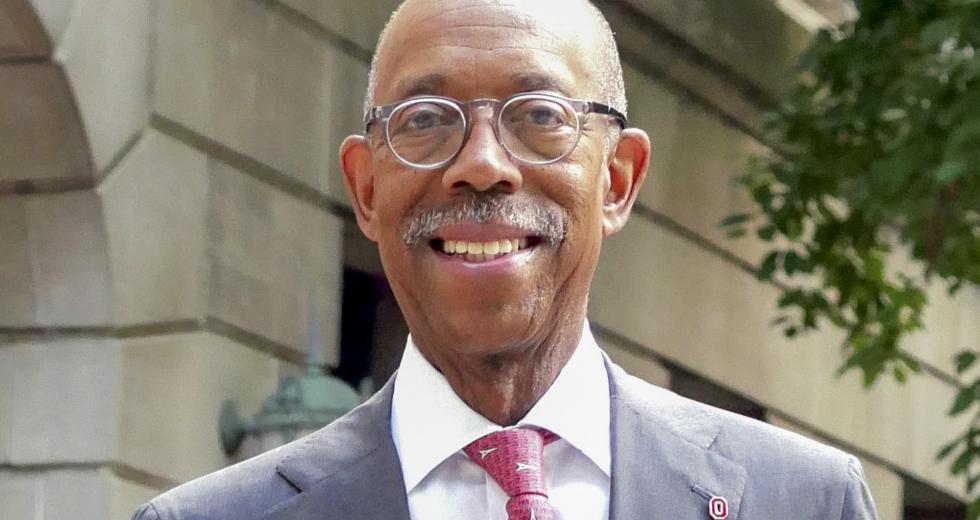After a six-month search, the University of California Regents picked Michael V. Drake as the new head of the school system, the first Black president in the system’s history.
Drake, the former president of Ohio State University and former chancellor of UC Irvine, succeeds Janet Napolitano as new president of the 10-campus system as the novel coronavirus pandemic upends higher education’s plans and finances.
The governing body of the UC, the Regents, formally picked Drake Tuesday. The 69-year-old Drake, who turns 70 in two days, spent decades working in various roles at the UC, including as vice president for health affairs. He earned his medical degree from UC San Francisco, where he taught for more than two decades.
“As the first person of color to serve as UC president, Dr. Drake arrives at an important point in the university’s journey. 2020 has been a tough year for us. Dr. Drake becoming the president of the University of California is a sign that good things are still possible this year,” said John A. Pérez, Chair of the Board of Regents.
During Drake’s time at OSU, the school saw its graduation and retention rates increase but also witnessed numerous controversies, including how it handled sexual abuse claims, according to The Columbus Dispatch.
Drake’s compensation is considerably higher than Napolitano’s. His base salary starts at $890,000, while Napolitano’s is at $570,000. According to 2018 data, Drake’s salary package at OSU included a base pay $856,000 and a total compensation of $1.2 million. His pay as chancellor of UC Irvine in 2013-14 was $392,000. Napolitano’s previous position as Secretary of Homeland Security paid $200,000.
His tenure as UC president will begin during a grueling recession, a stark contrast to the conditions Napolitano faced when she took the job in 2013. By then California had begun to mend after several years of declining state support due to the Great Recession, which the UC countered by doubling tuition after numerous price hikes between 2008 and 2011.
UC Student Association President Varsha Sarveshwar congratulated Dr. Drake in a statement, saying that during a meeting with student leaders today, Dr. Drake “affirmed his commitment to equity and inclusion, to accessibility and affordability, to rethinking public safety, and to student consultation.”
She added that she’s “hopeful that Dr. Drake will work in partnership with UCSA to follow through on these principles, and I challenge him to boldly pursue a vision for the University of California that is grounded in economic, social, and racial justice.”
Now, with a looming state budget cut of $300 million unless the federal government approves more stimulus and an economy rocked by unemployment, the UC system may be eyeing years of fiscal heartache and passing unpopular tuition hikes to make up for lost revenues. Adding to the uncertainty is a new statewide survey of current California college students and graduating high school seniors that show some of those students are rethinking their fall plans and attending the UC.
“I’m not sure I would envy the incoming president, that’s for sure,” said Debbie Cochrane, executive vice president at The Institute for College Access & Success.
At the May UC Regents meeting, some regents balked at the idea of increasing tuition, but Cochrane worries the temptation to find revenue through tuition hikes will grow if the fiscal doldrums persist. “Resistance to tuition increases in 2020 may not mean much in 2022 if the economy hasn’t recovered significantly,” she said.
Some of the tools to extract more tuition dollars from students available to the UC aren’t on the table anymore. As the great recession subsided and family incomes improved, more out-of-state students began attending the UCs. Between 2011 and 2019 the share of UC undergraduates who came from out-of-state jumped from around 7% to 18%, bringing with them about triple the tuition dollars in-state students pay. But in 2017, the UC, after pressure from lawmakers, placed caps on the share of out-of-state students each campus can enroll.
Nor can the UC raise tuition without seeing some of its state support dwindle. Because the state’s chief financial aid grant, the Cal Grant, covers the tuition of the UC and California State University, any increase in tuition means a greater expense to the state, which funds the Cal Grant. In recent years lawmakers in the state budget have included language that would take away state funding equal to the rising cost of the Cal grant caused by a UC or CSU tuition increase. The UC also pours in a third of revenue from tuition hikes into financial aid. In 2016-17, 57% of California undergraduates at the UC did not pay tuition.
“The tools that are available today to help us weather a crisis are not as evident as the tools that were available in 2008,” said Robert Powell, a chemical engineering professor at UC Davis who was chair of the Academic Senate when it played a role in picking outgoing Janet Napolitano in 2013.
“I think she had a very strong commitment to the public mission of the University of California,” Powell said of what he liked about Napolitano.
Other challenges for Drake include strengthening ties between the K-12 system and the university, said Christopher J. Nellum, deputy director of research and policy at Education Trust – West. Nellum said that while “we’ve heard in the past the University of California say they don’t have a lot of control over what K-12 does,” the system can work with California high schools to increase the number of courses offered that are required for UC and CSU admission, known as A-G courses that cover subjects in English, math, social studies and science, among others. According to a 2017 Public Policy Institute of California report, “only 86 percent of California’s high schools offered the full A–G science sequence.”
Doing so could increase the number of black and Latino students who are eligible for the UC. Improving access to UC-required high school courses is an important goal on its own, Nellum said. It could also be another pathway to enrolling more Black and Latino students along with Proposition 16, a measure on the ballot in November that will allow voters to approve the use of race-based admissions and hiring practices. While California’s Black population is more than 6%, UC’s enrollment is only 4%. Among Californians, 39% are Latino, but 25% are Latino at the UC. Also hurting equity at the UC are the space constraints of its campuses. Along with the CSU, tens of thousands of qualified students are denied spots at their preferred universities.
In another bid to make the UCs more inclusive, the regents in May dropped the SAT/ACT testing requirement for admissions in May. Among Drake’s other responsibilities will be to oversee a possible replacement to those tests.
The UC paid $150,000 to the executive search firm Storbeck/Pimentel & Associates to conduct the search for Drake. The firm completed between 175 and 200 searches for deans, chancellors and other executives for the UC, said Alberto Pimentel, the firm’s managing partner and cofounder.
“I was the first woman to be the president of the University of California, and I recognize the significance of these firsts,” said Napolitano, adding that she hopes “that this kind of leadership diversity at our nation’s universities will soon become commonplace.”
–
CalMatters.org is a nonprofit, nonpartisan media venture explaining California policies and politics.
Recommended For You

Higher Calling
Architects and colleges collaborate to create holistic, functional and artistic spaces to meet the shifting needs of today’s students
These six Capital Region higher-education projects, completed in the last decade, offer inspired and intentional learning spaces.

How Leaders Can Build True Inclusion
Adrienne S. Lawson, of UC Davis Health, talks about how leaders can promote workplace inclusion and justice
As the U.S. grapples with the COVID-19 pandemic, factors such as socioeconomic status, education, neighborhood and employment play a pivotal role in the fight against systemic racism and social injustice.

Up to the Task
Nehemiah Emerging Leaders Program founder Scott Syphax on how emerging leaders can help achieve social justice
In June, the Sacramento-based Nehemiah Emerging Leaders Program addressed the recent deaths of George Floyd, Ahmaud Arbery, Breonna Taylor, Stephon Clark and other Black people at the hands of the police in an open letter to the greater Sacramento community.

Learning to Pivot
New college grads are adapting to an economy and job market hard hit by the coronavirus pandemic
As college seniors finished their classes online, the impact of the coronavirus pandemic complicated their job prospects.



